|
View: 21168|Reply: 5
|
Tempat-Tempat Bersejarah
[Copy link]
|
|
|

Peace Park
Peace Park at Layang-Layangan is situated close to Surrender Point, the place where the 32nd Japanese Southern Army surrendered to the 9th Australian Imperial Forces on 9 September 1945. The Japanese arrived at Labuan on 1 January 1942, less than a month after they had started their campaign in Malaya at Kota Baru and took formal possession of the island on the 3rd, after facing no resistance.
They occupied Labuan for four years, even renaming it Pulau Maida, or Maidashima after General Maida, the Chief Commander of the Japanese forces in Borneo. He was on his way to Labuan from Sarawak to open the airstrip there when he died in an air crash at Bintulu. The airstrip was built by the Japanese who found it was a good location for their operations in North Borneo. For Labuan, the end of the Japanese Occupation came abruptly with the re-taking of the island by the Allied forces. The capture of Labuan was seen as essential for recovering supplies of oil, rubber and timber from the mainland of Borneo. It would also serve as a base to help the Allies recapture Singapore.
A convoy of 100 ships were sent from Merotai. On 10 June 1945, they reached Labuan and an attack was launched by the 9th Australian Division. It was a successful attack, resulting in the surrender of the Japanese troops.
The Peace Park was built as a memorial and renunciation of the horrors of the war. It is dominated by the memorial mound which is surrounded by landscaped gardens and pavilions. Small ponds with stone bridges and park seats are all Japanese-inspired. A bronze plaque commemorating the Surrender is mounted on a stone slab near the entrance.
[ Last edited by kuppit on 7-9-2004 at 12:01 PM ] |
|
|
|
|
|
|
|
|
|
|
|
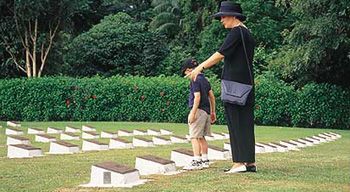
World War II Memorial
This Memorial is situated at Jalan Tanjung Batu. 3,908 graves of soldiers who either died in battle or captivity lie here. Most of the soldiers were Australians and British with some from the Punjab Signal Corp, New Zealand as well as a few locals.
In February 1945, the Japanese, apprehending an Allied landing in the Sandakan area, started to force march the prisoners to Ranau on which was what came to be known as the infamous Ranau Death March. Hundreds upon hundreds perished along the way and those who were left behind at the Sandakan POW camp also died or were killed. Many of the dead were reburied here at Labuan.
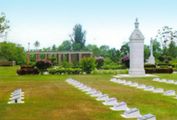

On 10 June 1945, Allied troops landed at Brown beach at Tanjung Purun to begin what was to be the liberisation of Borneo from the Japanese. Prior to this, Labuan town was heavily bombed aerially to flush out the enemies. Most of the buildings were destroyed. At the place known as the Pocket fighting also took place.
The remains of the Allied troops were gathered from all over Borneo to be interred at the Cemetery. The graves lie in long neat rows all bearing a plaque, mostly identified, many not, but 'known unto God'. The Labuan War Cemetery and Memorial is visited very regularly by War Veteran groups, especially from Australia who have included Labuan as an important destination on their battle-field tours circuit. On the first Sunday of November every year, a service to mark Remembrance Day is held here and is attended by locals and foreign visitors.
The place was constructed, and is maintained by Commonwealth War Graves Commission.
The lawns are beautiful kept and visitors will appreciate the peace and tranquility of the place as they seek to understand the senselessness of the deaths of so many brave young men.
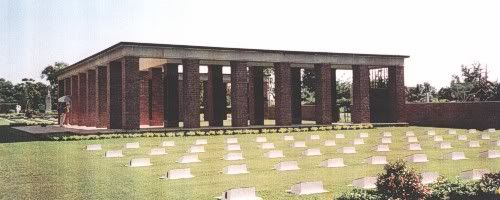
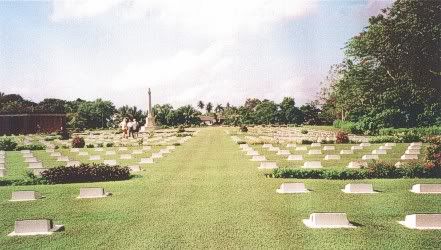
[ Last edited by kuppit on 8-9-2004 at 09:56 AM ] |
|
|
|
|
|
|
|
|
|
|
|

An Archeological Mystery
Situated on a rise at Tanjung Kubong is the famous "Chimney", a 106 feet high red brick stack believed to be linked to the coal mining days of Labuan. The Chimney, 106 feet tall, was made from more than 23,000 pieces of red bricks imported from ngland. The bricks layering and works are typical of British style.
The Chimney was long thought to be nothing more than a ventilation shaft. However, recent findings revealed that there were no traces of smokes or burning to suggest its use as a chimney as popularly believed. Careful digging has revealed at least 12 layers of bricks beneath the surface. The structure sits firmly on a large tract of limestone rock containing rich kaolin or porcelain clay, which provided the strong foundation.
The Chimney is still very much a mystery until today. Various hypothesis has been put forward to its purpose. Some said it was an unfinished mansion. While others said it was a light house beaconing passing ships. In its heyday, a thriving settlement was built at the sea front area below the Chimney. It was then used as a bell tower to announce the arrival of ships to the residents below. It has become an intriguing riddle that fascinates locals and visitors alike.
[ Last edited by kuppit on 7-9-2004 at 11:56 AM ] |
|
|
|
|
|
|
|
|
|
|
|
Tanjung Kubong Tunnels

Coal mining in 18th century Labuan
The northern tip of the island is called Tanjung Kubong. An expansive network of underground tunnels and deep wells are found in this area. This is the site of coal mining, which started in 1847. The mine was operated by various British companies for 64 years. The last one, the New Central Borneo, installed an 8 mile long railway track to Victoria Port to facilitate the export of the coal. A series of mining accidents led to the closure of the mine in 1911. The area is dotted with pits and tunnels. Old bricks and pieces of rail tracks and rusted cables can still be seen strewn on the ground. One can actually enter a low tunnel with the help of a short rope and emerge from the top. Across the road next to the Chimney, is a vertical well. It is 10 feet wide and measuring some 100 feet deep. At the bottom of this well are found entrances of more tunnels, which are yet to be explored. |
|
|
|
|
|
|
|
|
|
|
|
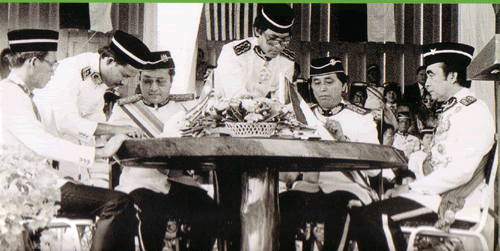
"Saya berdoa kepada Allah agar Semenanjung, Sabah, Sarawak & Labuan akan selalu bersatu padu sebagai satu Malaysia"[/b]
Perdana Menteri
Tun Dr. Mahathir
Selepas Menandatangani Pengisytiharan
Labuan sebagai Wilayah Persekutuan
Pada 16 April 1984 |
|
|
|
|
|
|
|
|
|
| |
Category: Negeri & Negara
|